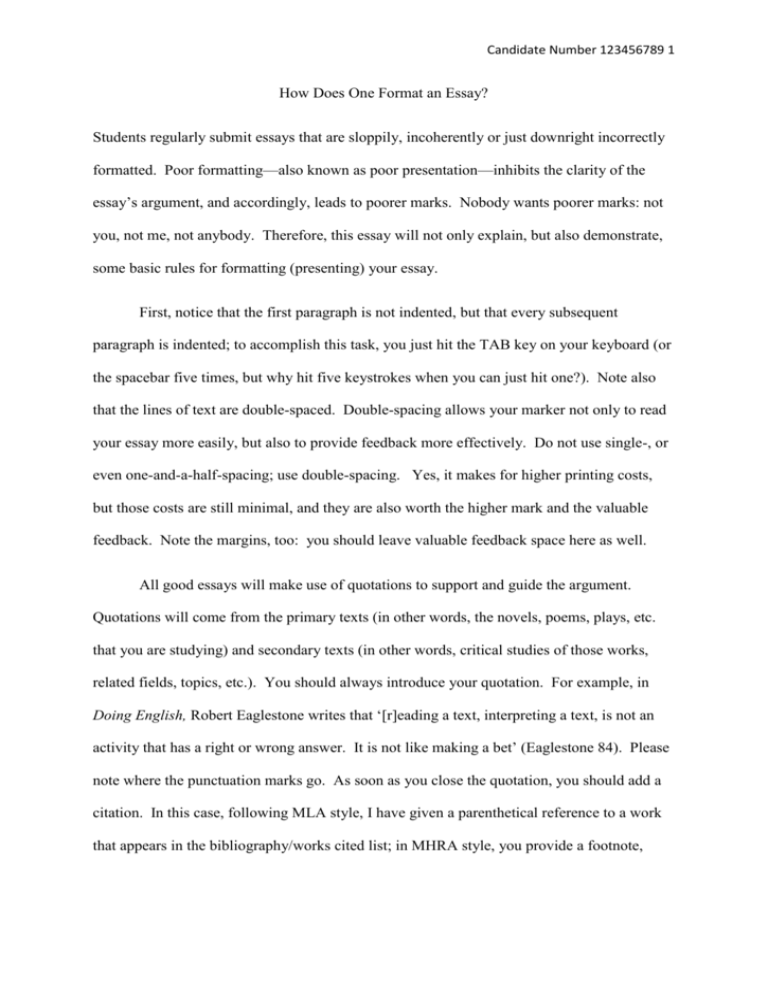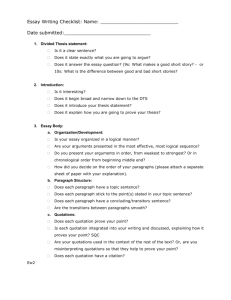How Does One Format An Essay
advertisement

Candidate Number 123456789 1 How Does One Format an Essay? Students regularly submit essays that are sloppily, incoherently or just downright incorrectly formatted. Poor formatting—also known as poor presentation—inhibits the clarity of the essay’s argument, and accordingly, leads to poorer marks. Nobody wants poorer marks: not you, not me, not anybody. Therefore, this essay will not only explain, but also demonstrate, some basic rules for formatting (presenting) your essay. First, notice that the first paragraph is not indented, but that every subsequent paragraph is indented; to accomplish this task, you just hit the TAB key on your keyboard (or the spacebar five times, but why hit five keystrokes when you can just hit one?). Note also that the lines of text are double-spaced. Double-spacing allows your marker not only to read your essay more easily, but also to provide feedback more effectively. Do not use single-, or even one-and-a-half-spacing; use double-spacing. Yes, it makes for higher printing costs, but those costs are still minimal, and they are also worth the higher mark and the valuable feedback. Note the margins, too: you should leave valuable feedback space here as well. All good essays will make use of quotations to support and guide the argument. Quotations will come from the primary texts (in other words, the novels, poems, plays, etc. that you are studying) and secondary texts (in other words, critical studies of those works, related fields, topics, etc.). You should always introduce your quotation. For example, in Doing English, Robert Eaglestone writes that ‘[r]eading a text, interpreting a text, is not an activity that has a right or wrong answer. It is not like making a bet’ (Eaglestone 84). Please note where the punctuation marks go. As soon as you close the quotation, you should add a citation. In this case, following MLA style, I have given a parenthetical reference to a work that appears in the bibliography/works cited list; in MHRA style, you provide a footnote, Candidate Number 123456789 2 following the formatting here.1 It is important to use a consistent style when citing sources; the point of referencing is to allow a reader to look up where your quotations came from, in case he or she would like to see the wider context in which the quotation appears. In MHRA style, for subsequent citations from the same source, you just cite the author’s name and page number in a footnote. Once you have quoted something, explain what it means, and proceed with your analysis of why that quotation, and its meaning, matters in the context of your argument. Each page should bear your candidate number and the page number; this way, when your clumsy lecturer stumbles in the corridor and throws his or her pile of marking all over the place, he or she can still read your essay in the correct order; stapling your essay helps, too. As the preceding paragraph demonstrates, book titles should be italicised, but the quotations themselves should be written in plain text. Titles of essays, poems and parts of works should be in single inverted commas. Always indicate line endings when quoting verse; if you are quoting two lines, use a slash. If quoting more than two, indent the quotation. For example, in the opening of his poem, ‘Dream Song 14’, John Berryman writes, ‘Life, friends, is boring. We must not say so. / After all, the sky flashes, the great sea yearns’ (Berryman 16). In the final stanza, the poet concludes: And the tranquil hills, & gin, look like a drag and somehow a dog has taken itself & its tail considerably away into mountains or sea or sky, leaving behind: me, wag. (Berryman) 1 Robert Eaglestone, Doing English: A Guide for Literature Students, 3rd edn (London: Routledge, 2009), p.84. Candidate Number 123456789 3 Similarly, you might find yourself quoting from a longer passage from a work. When your quotation runs for forty words or more (or two or more lines of verse), you should set it apart, rather than enclosing it in quotation marks. Eaglestone also writes that: a literary work does have a meaning, but it isn’t a puzzle or a secret to be found out, placed there in code by a genius author. Instead, it’s something that grows as an interaction between the readers and the text itself. Each reader is able—or should be able—to interpret and to produce an array of different and stimulating meanings. You shouldn’t be restricted by wondering what an author really meant. (Eaglestone 89) After the long quotation, you should continue your explanation and analysis as normal, without indenting, because you are not writing a new paragraph but continuing this part of your argument, following on from the interesting and relevant (but long) quotation. Please note from these different ways of quoting that there are also different ways of punctuating as you introduce the quotation; the important thing is that your punctuation matches the grammatical construction into which you have fit your quotation. Though not strictly speaking part of the presentation, the style in which you write your essay is also vitally important. You need to adopt a style of writing that does justice to the intelligence and complexity both of your argument and also of the primary and secondary texts you are employing in the shaping of your essay. Standard Written English takes a more formal tone than spoken English; you should keep this in mind as you write. While you do not necessarily need to avoid using contractions, if you do avoid them (as I have done here, using ‘do not’ instead of ‘don’t’ and ‘I have’ instead of ‘I’ve’) it will help you to focus on writing more precisely and formally. You should also avoid excessive use of forms of the verb ‘to be’, which is a boring verb, and also often leads to passive grammar. This next point might seem silly, but you should also make sure you understand the definition of every word Candidate Number 123456789 4 you employ; do not use fancy words just because you think they make you sound intelligent. The trick in creating a formal tone is not to use big words, but to use your working vocabulary precisely.2 The same advice goes for punctuation: make sure you know how and when to use a semicolon, a colon, a comma or a full stop; good punctuation is just as important as good diction. This essay has explained and demonstrated the basic aspects of essay presentation. Note that the introductory paragraph ended with a thesis statement, which has just been restated as the first sentence of the concluding paragraph. Restating your thesis statement at the start of the conclusion is not strictly necessary, but it does provide focus, and avoids opening the concluding paragraph with the toxic phrase, ‘in conclusion’. It will be worth your while to invest in a copy of the MHRA and/or MLA style guide, because they will tell you everything else you need to know, and give you guidance on a variety of subtleties that, properly enacted, will make your essay fizzle with life and style. * This essay was written by Douglas Cowie, with input and editorial advice from Robert Eaglestone, Judith Hawley, Eric Langley and Jennifer Neville, for students of the Department of English at Royal Holloway, University of London. * 2 Please note also that while ‘relatable’ is indeed the adjectival form of ‘relate’, it does not mean what you probably think it means; ‘Pip’s naïveté makes him more relatable’ is not a good sentence about Great Expectations. It is probably best not to use this word at all. Candidate Number 123456789 5 Bibliography (in MLA format) Berryman, John, ‘Dream Song 14’. In The Dream Songs. 1969. New York: The Noonday Press, 1995. Eaglestone, Robert. Doing English: A Guide for Literature Students. 3rd ed. London: Routledge, 2009. Modern Humanities Research Association. MHRA Style Guide. 2nd ed. London: Modern Languages Research Association, 2008. Modern Languages Association, The. MLA Handbook for Writers of Research Papers. 7th ed. New York: The Modern Languages Association, 2009. Bibliography (in MHRA format) Berryman, John, ‘Dream Song 14’, in The Dream Songs (1969; New York: The Noonday Press, 1995) Eaglestone, Robert, Doing English: A Guide for Literature Students, 3rd edn (London: Routledge, 2009) Modern Humanities Research Association, MHRA Style Guide, 2nd edn (London: Modern Languages Research Association, 2008) Modern Languages Association, The, MLA Handbook for Writers of Research Papers, Candidate Number 123456789 6 7th edn (New York: The Modern Languages Association, 2009)









